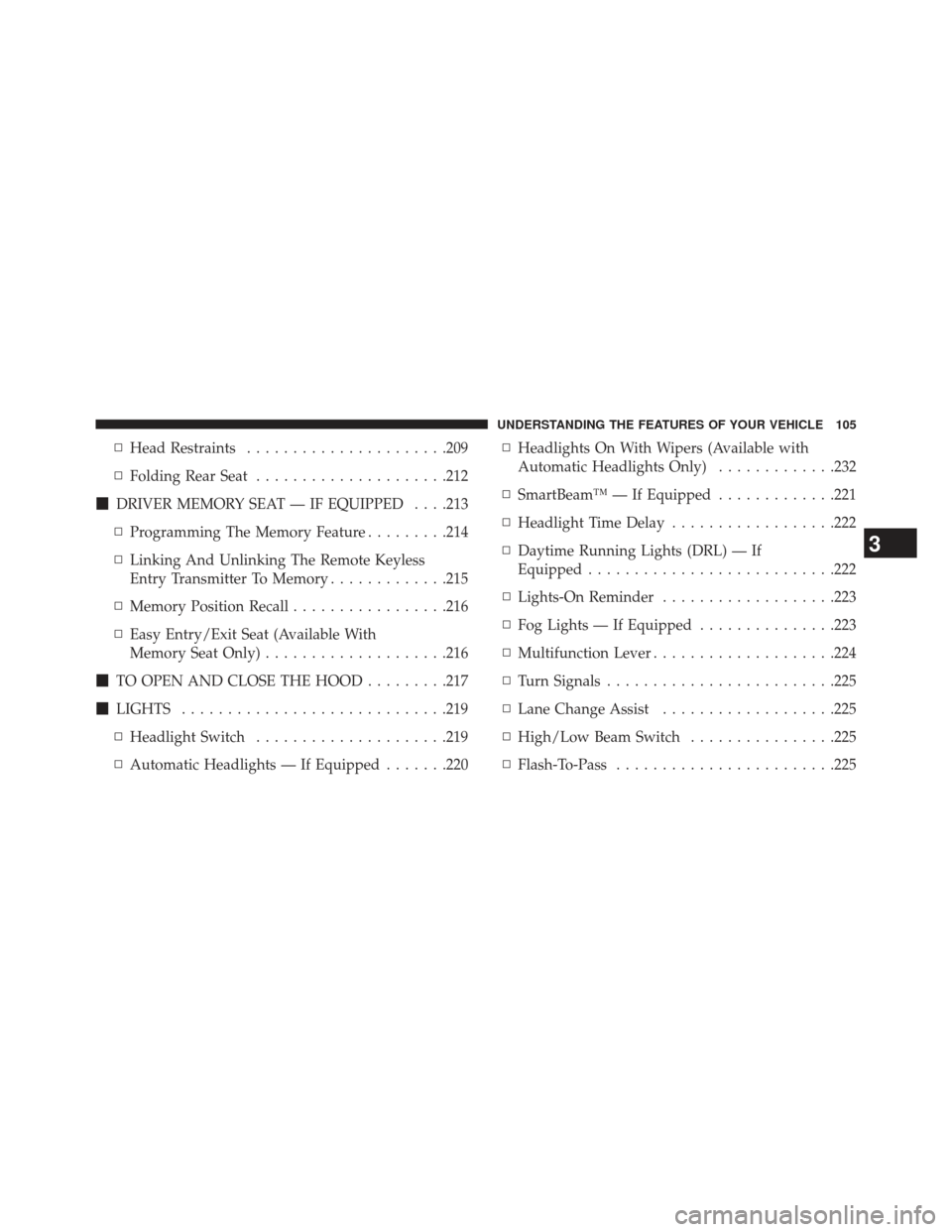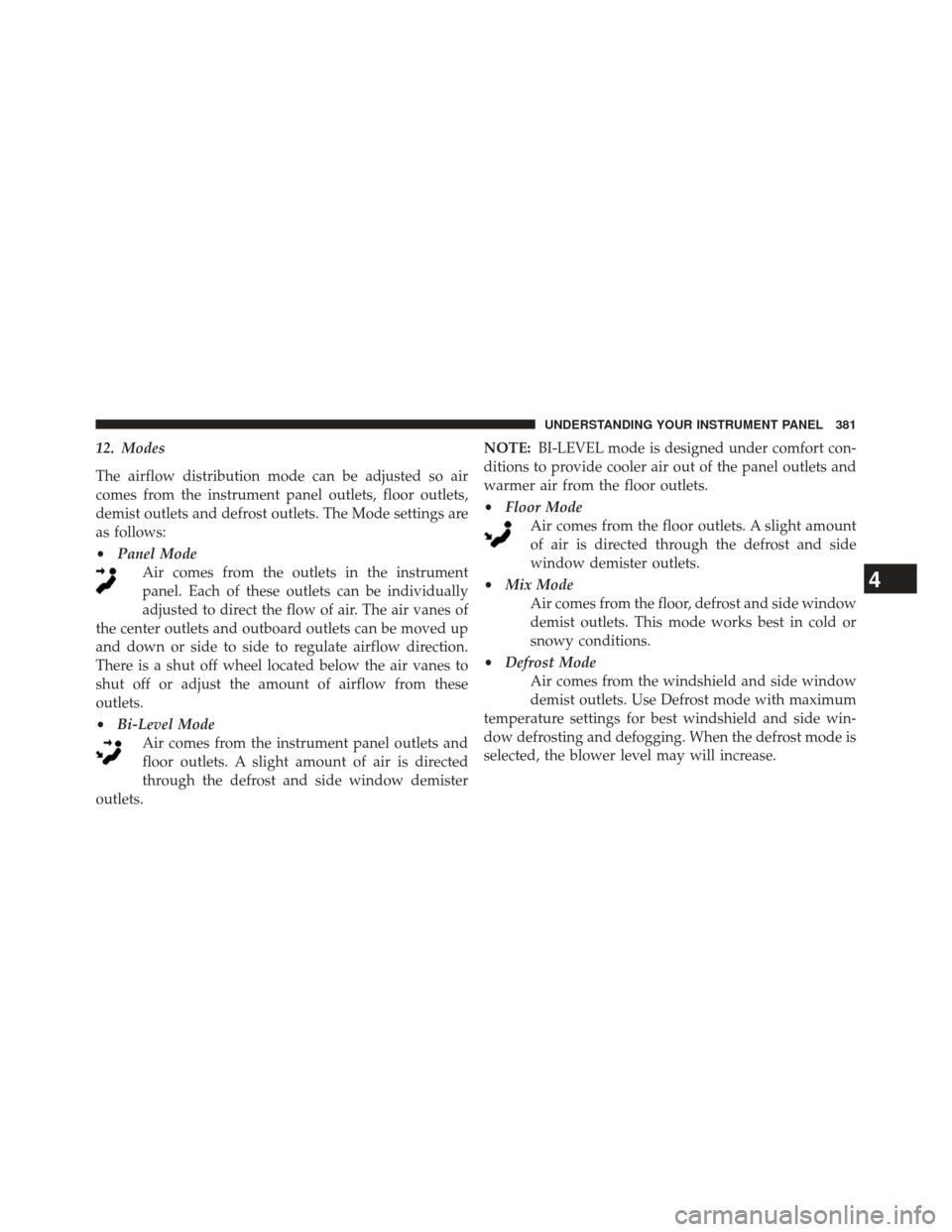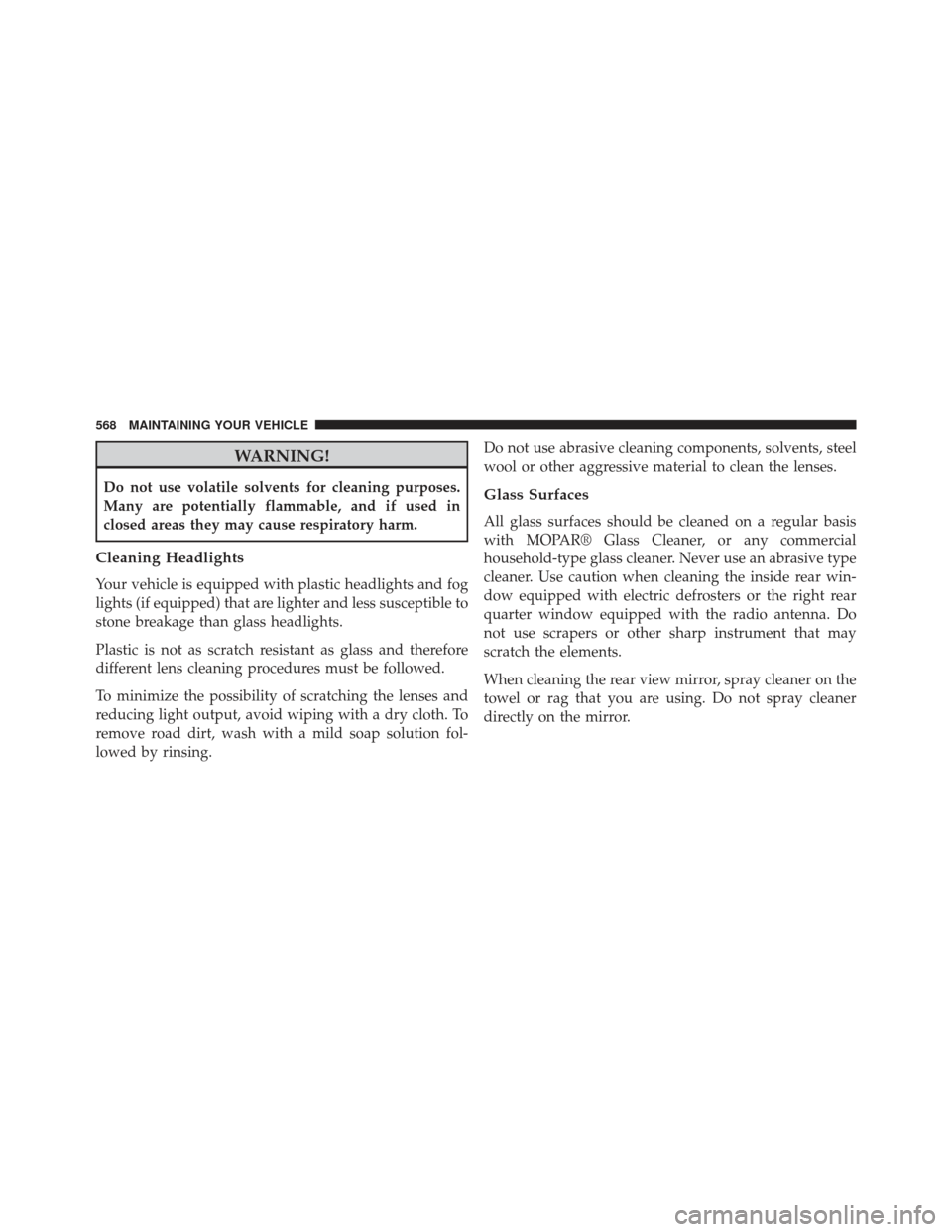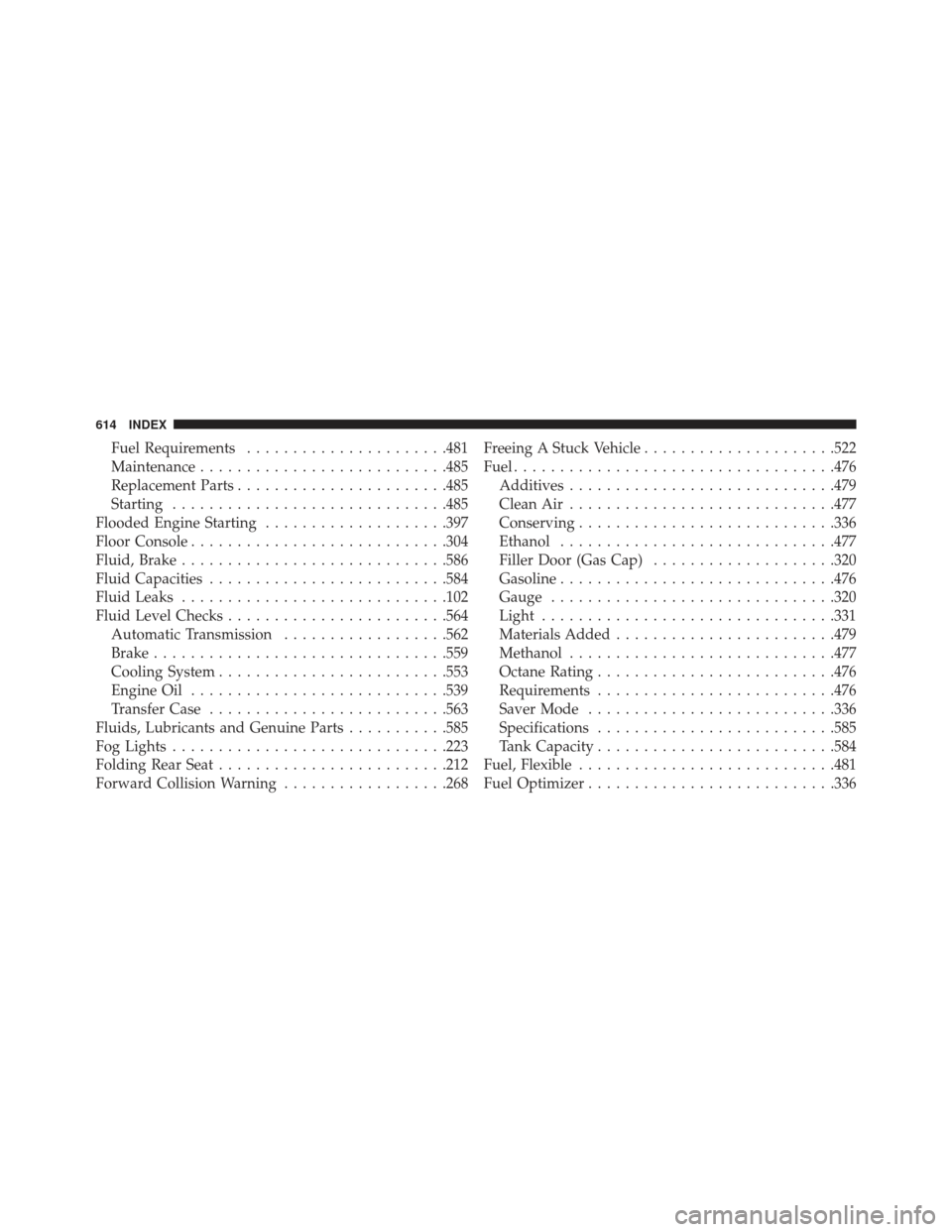Page 107 of 631

▫Head Restraints ..................... .209
▫ Folding Rear Seat .....................212
� DRIVER MEMORY SEAT — IF EQUIPPED . . . .213
▫ Programming The Memory Feature .........214
▫ Linking And Unlinking The Remote Keyless
Entry Transmitter To Memory .............215
▫ Memory Position Recall .................216
▫ Easy Entry/Exit Seat (Available With
Memory Seat Only) ....................216
� TO OPEN AND CLOSE THE HOOD .........217
� LIGHTS ............................ .219
▫ Headlight Switch .....................219
▫ Automatic Headlights — If Equipped .......220▫
Headlights On With Wipers (Available with
Automatic Headlights Only) .............232
▫ SmartBeam™ — If Equipped .............221
▫ Headlight Time Delay ..................222
▫ Daytime Running Lights (DRL) — If
Equipped .......................... .222
▫ Lights-On Reminder ...................223
▫ Fog Lights — If Equipped ...............223
▫ Multifunction Lever ....................224
▫ Turn Signals ........................ .225
▫ Lane Change Assist ...................225
▫ High/Low Beam Switch ................225
▫ Flash-To-Pass ....................... .225
3
UNDERSTANDING THE FEATURES OF YOUR VEHICLE 105
Page 221 of 631
LIGHTS
Headlight Switch
The headlight switch is located on the left side of
the instrument panel. This switch controls the
operation of the headlights, parking lights, instru-
ment panel lights, instrument panel light dimming, inte-
rior lights and fog lights.
Rotate the headlight switch clockwise to the first detent
for parking light and instrument panel light operation.
Rotate the headlight switch to the second detent for
headlight, parking light and instrument panel light op-
eration.
Headlight Switch
3
UNDERSTANDING THE FEATURES OF YOUR VEHICLE 219
Page 225 of 631
Lights-On Reminder
If the headlights or parking lights are on after the ignition
is turned OFF, a chime will sound to alert the driver
when the driver’s door is opened.
Fog Lights — If Equipped
The front fog light switch is built into the headlight
switch.To activate the front fog lights, turn on the parking
lights or the low beam headlights and press the
headlight switch. To turn off the front fog lights, either
press the headlight switch a second time or turn off the
headlight switch.
Fog Light Switch
3
UNDERSTANDING THE FEATURES OF YOUR VEHICLE 223
Page 226 of 631
An indicator light in the instrument cluster illuminates
when the fog lights are turned on.
NOTE:The fog lights will operate with the low beam
headlights or parking lights on. However, selecting the
high beam headlights will turn off the fog lights.
Multifunction Lever
The multifunction lever controls the operation of the turn
signals, headlight beam selection and passing lights. The
multifunction lever is located on the left side of the
steering column.
Multifunction Lever
224 UNDERSTANDING THE FEATURES OF YOUR VEHICLE
Page 318 of 631

INSTRUMENT CLUSTER DESCRIPTIONS
1. Tachometer
This gauge measures engine revolutions-per-minute
(RPM x 1000).
2. AWD (All Wheel Drive) Indicator — If Equipped
The AWD indicator will illuminate when All Wheel Drive
(AWD) is activated.
3. Park/Headlight ON Indicator — If EquippedThis indicator will illuminate when the park
lights or headlights are turned on.
4. Turn Signal Indicators The arrow will flash with the exterior turn signal
when the turn signal lever is operated. If the vehicle electronics sense that the vehicle is driven
more than 1 mile (1.6 km) with either turn signal on, a
continuous chime will sound to alert you to turn the
signals off. If either indicator flashes at a rapid rate, check
for a defective outside light bulb.
5. Front Fog Light Indicator — If Equipped
This indicator will illuminate when the front fog
lights are on.
6. High Beam Indicator
This indicator shows that the high beam head-
lights are on. Push the multifunction lever for-
ward to switch the headlights to high beam, and pull
toward yourself (normal position) to return to low beam.
316 UNDERSTANDING YOUR INSTRUMENT PANEL
Page 383 of 631

12. Modes
The airflow distribution mode can be adjusted so air
comes from the instrument panel outlets, floor outlets,
demist outlets and defrost outlets. The Mode settings are
as follows:
•Panel Mode
Air comes from the outlets in the instrument
panel. Each of these outlets can be individually
adjusted to direct the flow of air. The air vanes of
the center outlets and outboard outlets can be moved up
and down or side to side to regulate airflow direction.
There is a shut off wheel located below the air vanes to
shut off or adjust the amount of airflow from these
outlets.
• Bi-Level Mode
Air comes from the instrument panel outlets and
floor outlets. A slight amount of air is directed
through the defrost and side window demister
outlets. NOTE:
BI-LEVEL mode is designed under comfort con-
ditions to provide cooler air out of the panel outlets and
warmer air from the floor outlets.
• Floor Mode
Air comes from the floor outlets. A slight amount
of air is directed through the defrost and side
window demister outlets.
• Mix Mode
Air comes from the floor, defrost and side window
demist outlets. This mode works best in cold or
snowy conditions.
• Defrost Mode
Air comes from the windshield and side window
demist outlets. Use Defrost mode with maximum
temperature settings for best windshield and side win-
dow defrosting and defogging. When the defrost mode is
selected, the blower level may will increase.
4
UNDERSTANDING YOUR INSTRUMENT PANEL 381
Page 570 of 631

WARNING!
Do not use volatile solvents for cleaning purposes.
Many are potentially flammable, and if used in
closed areas they may cause respiratory harm.
Cleaning Headlights
Your vehicle is equipped with plastic headlights and fog
lights (if equipped) that are lighter and less susceptible to
stone breakage than glass headlights.
Plastic is not as scratch resistant as glass and therefore
different lens cleaning procedures must be followed.
To minimize the possibility of scratching the lenses and
reducing light output, avoid wiping with a dry cloth. To
remove road dirt, wash with a mild soap solution fol-
lowed by rinsing.Do not use abrasive cleaning components, solvents, steel
wool or other aggressive material to clean the lenses.
Glass Surfaces
All glass surfaces should be cleaned on a regular basis
with MOPAR® Glass Cleaner, or any commercial
household-type glass cleaner. Never use an abrasive type
cleaner. Use caution when cleaning the inside rear win-
dow equipped with electric defrosters or the right rear
quarter window equipped with the radio antenna. Do
not use scrapers or other sharp instrument that may
scratch the elements.
When cleaning the rear view mirror, spray cleaner on the
towel or rag that you are using. Do not spray cleaner
directly on the mirror.
568 MAINTAINING YOUR VEHICLE
Page 616 of 631

Fuel Requirements..................... .481
Maintenance .......................... .485
Replacement Parts ...................... .485
Starting ............................. .485
Flooded Engine Starting ....................397
Floor Console ........................... .304
Fluid, Brake ............................ .586
Fluid Capacities ......................... .584
Fluid Leaks ............................ .102
Fluid Level Checks ....................... .564
Automatic Transmission ..................562
Brake ............................... .559
Cooling System ........................ .553
Engine Oil ........................... .539
Transfer Case ......................... .563
Fluids, Lubricants and Genuine Parts ...........585
Fog Lights ............................. .223
Folding Rear Seat ........................ .212
Forward Collision Warning ..................268 Freeing A Stuck Vehicle
.....................522
Fuel .................................. .476
Additives ............................ .479
Clean Air ............................ .477
Conserving ........................... .336
Ethanol ............................. .477
Filler Door (Gas Cap) ....................320
Gasoline ............................. .476
Gauge .............................. .320
Light ............................... .331
Materials Added ....................... .479
Methanol ............................ .477
Octane Rating ......................... .476
Requirements ......................... .476
Saver Mode .......................... .336
Specifications ......................... .585
T
ank Capacity ......................... .584
Fuel, Flexible ........................... .481
Fuel Optimizer .......................... .336
614 INDEX